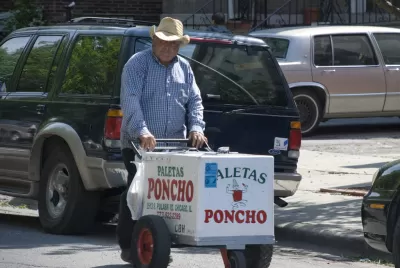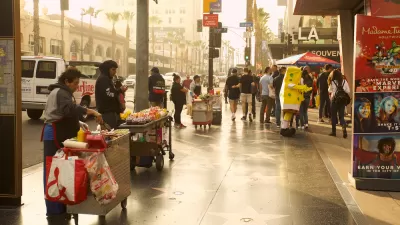While recent crackdowns on street vending suggest it is a problem to be fixed, the reality is that street vendors energize urban spaces and make them more accessible for everyone.

Alissa Walker makes the case that street vendors contribute to public spaces in important ways. "In places where city leaders have made very little effort to improve the experience for those walking, biking, or riding transit, it’s the people selling goods or serving food in those same spaces who make streets vibrant, welcoming, and safe for all."
She says that the role of vendors is most evident in the most neglected parts of cities, which feel unsafe without the presence of people. "Waiting for the bus alone at night, at a poorly lit corner in front of a vacant building, just hearing the scrape of plastic stools at the taco stand posted up outside a nearby auto body shop is comforting. I can confidently say I feel safer because people are prepping, cooking, and devouring al pastor on my sidewalk," says Walker.
Street vendors are not criminals, argues Walker, and the recent handcuffing of a churro vendor in a New York City subway station is an example of unnecessary policing of urban spaces. The arguments against street vending, that vendors pose a danger or block sidewalks, are not valid, she says. "When law enforcement officials see a churro cart as an obstacle, they likely don’t understand the value that a churro cart provides to the rest of us."
FULL STORY: Why street vendors make cities feel safer

Planetizen Federal Action Tracker
A weekly monitor of how Trump’s orders and actions are impacting planners and planning in America.

Congressman Proposes Bill to Rename DC Metro “Trump Train”
The Make Autorail Great Again Act would withhold federal funding to the system until the Washington Metropolitan Area Transit Authority (WMATA), rebrands as the Washington Metropolitan Authority for Greater Access (WMAGA).

The Simple Legislative Tool Transforming Vacant Downtowns
In California, Michigan and Georgia, an easy win is bringing dollars — and delight — back to city centers.

The States Losing Rural Delivery Rooms at an Alarming Pace
In some states, as few as 9% of rural hospitals still deliver babies. As a result, rising pre-term births, no adequate pre-term care and harrowing close calls are a growing reality.

The Small South Asian Republic Going all in on EVs
Thanks to one simple policy change less than five years ago, 65% of new cars in this Himalayan country are now electric.

DC Backpedals on Bike Lane Protection, Swaps Barriers for Paint
Citing aesthetic concerns, the city is removing the concrete barriers and flexposts that once separated Arizona Avenue cyclists from motor vehicles.
Urban Design for Planners 1: Software Tools
This six-course series explores essential urban design concepts using open source software and equips planners with the tools they need to participate fully in the urban design process.
Planning for Universal Design
Learn the tools for implementing Universal Design in planning regulations.
Smith Gee Studio
City of Charlotte
City of Camden Redevelopment Agency
City of Astoria
Transportation Research & Education Center (TREC) at Portland State University
US High Speed Rail Association
City of Camden Redevelopment Agency
Municipality of Princeton (NJ)





























